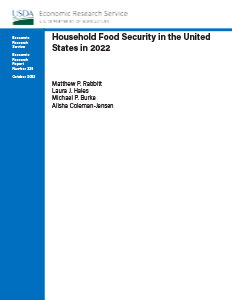Household Food Security in the United States in 2022
- by Matthew P. Rabbitt, Laura J. Hales, Michael P. Burke and Alisha Coleman-Jensen
- 10/25/2023
Overview
Most U.S. households have consistent, dependable access to enough food for active, healthy living—they are food secure. However, some households experience food insecurity at times during the year, meaning their access to adequate food is limited by a lack of money and other resources. USDA’s food and nutrition assistance programs aim to increase food security by providing low-income households access to food for a healthful diet, as well as nutrition education. USDA monitors the extent and severity of food insecurity in U.S. households through an annual, nationally representative survey sponsored and analyzed by USDA’s Economic Research Service (ERS). This report presents statistics from the survey that cover household food security, food expenditures, and use of Federal food and nutrition assistance programs in 2022.
See related tables: Statistical Supplement to Household Food Security in the United States in 2022 (AP-119)
How to Cite:
Rabbitt, M.P., Hales, L.J., Burke, M.P., & Coleman-Jensen, A. (2023). Household food security in the United States in 2022 (Report No. ERR-325). U.S. Department of Agriculture, Economic Research Service. https://doi.org/10.32747/2023.8134351.ers
Download
-
Entire report
Download PDF -
Report summary
Download PDF
We’d welcome your feedback!
Would you be willing to answer a few quick questions about your experience?

